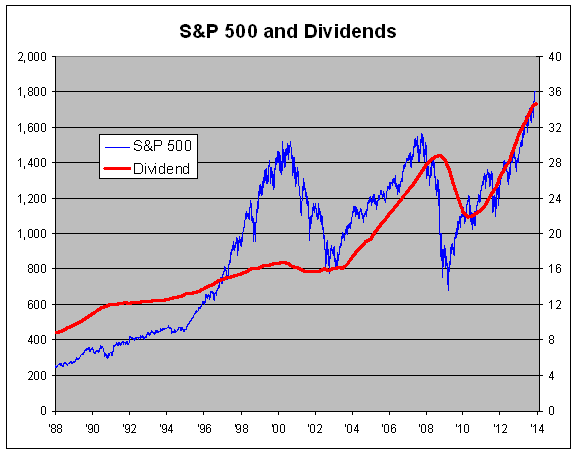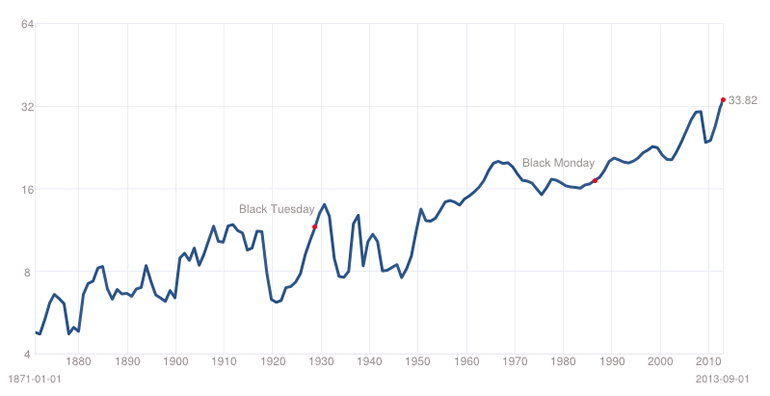While dividend size is not the primary driver of my investment decisions, I still love seeing dividend distributions arrive in my brokerage account and consider them a critical part of my portfolio’s total return.
Eddy Elfenbein of Crossing Wall Street created the chart below, plotting both the S&P 500 index value (blue) and its dividends (red). The vertical axes are scaled 50:1, so that when they cross the dividend yield is 2%. We see that while dividends don’t always go up in the short term, they have been bouncing back and growing along with stock prices today (unlike during the dot-com boom).

If you take a step back and look at the bigger picture, Multpl.com has a chart showing the dividend growth for the S&P 500 on a real (inflation-adjusted) basis since 1870. While the dividend yield remains at historical lows, the total amount of dividends still appear to grow faster than inflation over longer (10+ year) periods. Note the vertical axis is on a log-scale.

 The Best Credit Card Bonus Offers – November 2024
The Best Credit Card Bonus Offers – November 2024 Big List of Free Stocks from Brokerage Apps
Big List of Free Stocks from Brokerage Apps Best Interest Rates on Cash - November 2024
Best Interest Rates on Cash - November 2024 Free Credit Scores x 3 + Free Credit Monitoring
Free Credit Scores x 3 + Free Credit Monitoring Best No Fee 0% APR Balance Transfer Offers
Best No Fee 0% APR Balance Transfer Offers Little-Known Cellular Data Plans That Can Save Big Money
Little-Known Cellular Data Plans That Can Save Big Money How To Haggle Your Cable or Direct TV Bill
How To Haggle Your Cable or Direct TV Bill Big List of Free Consumer Data Reports (Credit, Rent, Work)
Big List of Free Consumer Data Reports (Credit, Rent, Work)
I’m an investor in the UK and like you I love to see divedend growth. It’s been a hard few years but finally I think globally Divedends are looking like they are on a steady increase 🙂
Not so sure,, average dividend increase for sp 500 over the past 130 years was 3.3% 5-6% since 1980s, now corporations are taking low interest debt to buy back shares. That reduces the equity, it will be easier to pay dividends, but it seems the growth is a little much especially as payout % seems to have increased in mature companies.. Seems too good to be true for long. I could be wrong, but I think the wealth effect since the 1990s has really messed things up in the market as well as 401k plan. Perhaps because of the demographic glut, there are a lot of baby boomers, too much of the nations wealth is tied up in financial security, in effect lowering yields as we have seen. As result, due to low interest rates, too little is “trickling” down to the lower traunches…. I would love to see a government run pension plan that pays a humble dividend that grows with inflation and can be passed on to ones heirs. The average dividend yield of the sp 500 was 4.5% today it is 1.9% , though inflations average was 3.3% and today its a little under 2%,,, somethings wrong with this picture. at the current trajectory, the 10 year note will yield 0% in 12 years… I don’t think the fed will be able to raise the interest rates. I think the long bonds are going lower. but I could be wrong. Now the ECB is about to print money, whats that going to do to the long bond yield. Easy money is easy go I guess.
Working through the math:
(33.82 / 4.59) ^ (1/142.5) = 1.4% annualized real growth in dividends
I would have expected something closer to 3%, as I would expect the real growth in dividends to be close to real growth in GDP over the very long run. Payout ratios used to be higher in the old days, and factoring that in brings it close to 2%. Still, we are missing about one percent a year. I’m wondering if this is the one percent “leakage” that some academics talk about, where issuance of new stock and so forth is leaking valuations about 1% per year.